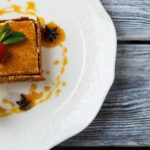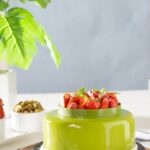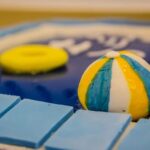Cake decorating is an essential aspect of baking that adds both visual appeal and taste to the final product. One crucial ingredient in this art form is sugar, which plays a significant role in creating stunning and delectable baked goods.
From providing stability and texture to enhancing sweetness, sugar is a key component in cake design. Whether you are a beginner or an experienced baker, understanding the importance of cake decorating with sugar can take your creations to a whole new level.
When it comes to cake decorating with sugar, the selection of sugar types, textures, and flavors is essential. Different types of sugar, such as granulated sugar, powdered sugar, and fondant, contribute unique qualities to cake designs. Some sugars add stability while others create delicate textures or intense sweetness. By choosing the right type of sugar for specific techniques or desired outcomes, bakers can elevate their creations and achieve professional results.
Mastering the basics of cake decorating with sugar involves learning various techniques that incorporate this ingredient seamlessly into designs. Techniques such as piping, molding, and stenciling allow bakers to create intricate patterns or shapes on cakes using different forms of sugar. Learning these techniques step-by-step can help beginners achieve impressive results and open doors to more advanced skill levels.
It’s not just about mastering the basics; there are also advanced sugar decorating techniques that allow bakers to create truly awe-inspiring designs. For those looking to push their creativity to new heights, exploring techniques like sugar flowers or intricate designs can yield show-stopping results. Through detailed explanations and visual examples, bakers can delve into the realm of complex and artistic creations achieved through the artistry of sugar.
The Art of Sugar Selection
Sugar is a key ingredient in cake decorating, playing a crucial role in creating visually appealing and tasty baked goods. The art of sugar selection involves choosing the right types, textures, and flavors to enhance different aspects of cake design.
When it comes to sugar used in cake decorating, there are several options to consider. Granulated sugar is the most common type and adds sweetness to cakes. Powdered sugar, also known as confectioners’ sugar, is finely ground granulated sugar that creates smooth icings and frostings. Fondant is a pliable icing made from sugar, water, and other ingredients that can be rolled out and used to cover cakes or create intricate decorations.
Each type of sugar contributes to different aspects of cake design. Granulated sugar provides structure and stability to baked goods while adding sweetness. Powdered sugar helps create smooth textures and enhances the sweetness of icings and frostings. Fondant provides a versatile canvas for creating various decorations such as flowers, figures, and intricate designs.
Choosing the right type of sugar for specific cake decorating techniques or desired outcomes is essential. For example, if you’re looking to create intricate details on a cake or make edible figures, fondant would be the best choice due to its malleability. On the other hand, if you want a smooth finish for your frosting or icing, powdered sugar would be ideal.
| Type of Sugar | Texture | Main Use |
|---|---|---|
| Granulated Sugar | Coarse | Baking; adds structure and stability |
| Powdered Sugar (Confectioners’ Sugar) | Fine | Icings, frostings; creates smooth textures |
| Fondant | Pliable | Covering cakes, creating intricate decorations |
Mastering the art of sugar selection is key for any baker looking to create beautifully decorated cakes. By understanding the different types, textures, and flavors of sugar and how they contribute to cake design, bakers can elevate their creations and make them visually stunning and delicious.
Mastering the Basics
Piping
Piping is one of the fundamental techniques in cake decorating that involves using a pastry bag fitted with a piping tip to create various designs on the surface of a cake. This technique allows bakers to add intricate patterns, borders, or personalized messages to their creations.
To master piping, it’s important to start with the right consistency of icing or buttercream. If the icing is too stiff, it may be difficult to pipe smoothly, while overly soft icing can result in messy and unstable designs.
To begin, fill a piping bag with your chosen icing and twist the open end closed. Hold the bag perpendicular to the cake’s surface and apply gentle pressure as you guide it along your desired design path. Practice steady hand movements and experiment with different piping tips to achieve varying effects such as stars, flowers, or lettering. Remember that consistency is key when it comes to maintaining even pressure while piping.
Molding
Molding sugar allows bakers to create three-dimensional shapes and figures for their cake designs. It involves manipulating sugar paste or fondant into specific forms before placing them onto the cake’s surface. Before getting started with molding, ensure that your hands are clean and lightly dusted with powdered sugar or cornstarch to prevent sticking.
To mold sugar, begin by kneading your sugar paste or fondant until it becomes pliable and easy to work with. Shape small portions of the paste into balls or logs and use your fingers or modeling tools to form desired shapes such as animals, flowers, or objects. Be patient and work slowly if necessary, as intricate details often require precision.
Stenciling
Stenciling is a versatile technique that adds elegant patterns to cakes by using stencils made from either flexible plastic sheets or durable paper cutouts. It provides an easy way for even beginners to achieve professional-looking decorations on their cakes.
Start by securing the stencil onto the side or top of your cake using gentle pressure or clean pins. Spread a thin layer of powdered sugar, cocoa powder, or edible luster dust over the stencil using a sifter or small kitchen brush. Carefully lift the stencil away to reveal the intricate design underneath. If desired, you can enhance the stenciled pattern with additional details like piped borders or accents.
By mastering these basic sugar decorating techniques, bakers can elevate their cake designs and create visually impressive treats. As always, practice makes perfect, so don’t be afraid to experiment and add your own personal touch to these techniques.
Going Beyond the Basics
In this section, we will explore advanced sugar decorating techniques that go beyond the basics. These techniques are perfect for bakers who want to take their cake decorating skills to the next level and create intricate and show-stopping designs. With these advanced techniques, you can truly push the boundaries of sugar artistry and wow your guests with visually stunning and delicious cakes.
One advanced sugar decorating technique is creating sugar flowers. Sugar flowers are delicate and realistic-looking blooms that can be used to decorate wedding cakes, birthday cakes, or any special occasion cake. To create sugar flowers, you will need a flower mold or cutters, floral wires, gum paste or fondant, and edible color dusts. This technique requires patience and attention to detail but can result in breathtaking edible floral arrangements.
Another advanced technique is sugar lace. Sugar lace adds an elegant and intricate touch to cakes by creating delicate lace patterns on the surface. To make sugar lace, you will need a lace mold or mat, icing sugar with added elements like gum tragacanth or tylose powder for stability, and water. The process involves spreading the mixture onto the lace mold or mat, allowing it to set, and carefully removing the lace pattern to apply onto the cake.
Lastly, intricate designs made entirely out of sugar can showcase exceptional creativity in cake decorating. From beautifully sculpted figurines to detailed architectural elements, these designs require skillful manipulation of fondant or gum paste into various shapes and forms. Tools like sculpting tools, silicone molds, edible paints, and dusts are often used in this advanced technique.
| Advanced Technique | Description |
|---|---|
| Sugar Flowers | Create delicate and realistic-looking blooms using gum paste or fondant. |
| Sugar Lace | Add elegant and intricate lace patterns to cakes using special molds or mats. |
| Intricate Sugar Designs | Create detailed designs by sculpting fondant or gum paste into various shapes and forms. |
Remember, these advanced techniques require practice and patience. Don’t be discouraged if your first attempts don’t turn out perfectly. Keep practicing and experimenting, and soon you’ll be able to create stunning sugar decorations that will amaze everyone who sees your cakes.
Sugar as a Canvas
When it comes to cake decorating with sugar, color plays a crucial role in bringing designs to life. The art of coloring sugar allows bakers to create stunning and vibrant cakes that are visually appealing. From natural food dyes to gel colors and airbrushing techniques, there is a wide range of options for bakers to explore when it comes to coloring sugar.
One popular method of coloring sugar is using natural food dyes. These dyes are made from fruits, vegetables, and other plant-based sources, making them a more natural and healthier option compared to artificial food colorings. Natural food dyes can also provide beautifully soft and muted tones, adding an elegant touch to cake designs.
Gel colors are another versatile option for coloring sugar decorations. Gel colors offer vibrant and intense shades that can be easily mixed and blended to achieve desired hues. They are highly concentrated, meaning only a small amount is needed to achieve the desired color. This makes them ideal for achieving bold and vibrant designs.
For those looking for even more precision and control over their color application, airbrushing is a technique worth exploring. Airbrushing allows bakers to seamlessly blend different colors together while creating smooth transitions on their cakes. This technique also provides the opportunity for intricate details and shading that may be challenging with traditional methods.
Overall, the possibilities of coloring sugar are endless when it comes to cake decorating. Bakers can experiment with different techniques, combinations, and effects to create unique and personalized designs that match any theme or occasion. Whether it’s a whimsical birthday cake or an elegant wedding masterpiece, mastering the art of coloring sugar opens up a world of creativity in cake decorating.
Sugar Sculpting
Creating edible cake toppers and figures is a popular and impressive form of cake decorating that can elevate any baked creation to the next level. Sugar sculpting offers endless possibilities for customization, allowing bakers to bring their cake themes or designs to life in a delicious and visually stunning way.
To begin sculpting with sugar, bakers will need a few key tools and ingredients. First and foremost, it is important to use sugar that is specifically designed for sculpting, such as modeling chocolate or gum paste. These types of sugar have the right consistency and pliability to be molded into intricate shapes without losing their structure. Bakers should also have various sculpting tools on hand, such as shaping tools, cutters, and brushes for applying color or detail.
When starting out with sugar sculpting, it is helpful to have some basic knowledge of shaping techniques. Begin by kneading the sugar until it is soft and pliable. From there, it can be shaped into simple forms like balls or cones before gradually moving on to more complex figures. For more detailed creations, bakers can use molds to achieve consistent shapes or add texture.
To create realistic textures in sugar sculptures, bakers can utilize different tools or techniques. For example, using a veining tool can mimic the veins in leaves or petals, while a ball tool can add depth and shape to flower petals or other rounded surfaces. Additionally, dusting powders in various colors can be used sparingly to add depth and dimension.
The possibilities for sugar sculpting are truly limitless. Bakers can design custom cake toppers that resemble people or animals, replicate objects like cars or buildings, or even create intricate scenes with multiple elements. This art form allows for complete creative expression and adds an extra touch of personalization to any cake design.
By exploring the art of sugar sculpting, bakers can take their cake decorating skills to new heights. With practice and experimentation, they can master the techniques of creating edible cake toppers and figures that will amaze and delight their clients, friends, and family. So grab some sugar, unleash your creativity, and let the magic of sugar sculpting transform your cakes into edible works of art.
Troubleshooting Sugar Decorations
Sugar decorations can elevate a cake’s appearance, but they can also present challenges for bakers. Understanding common issues that arise when working with sugar for cake decorating and knowing how to troubleshoot them is essential for achieving successful results. In this section, we will address some of the most common challenges faced by bakers when working with sugar decorations and provide quick and effective solutions.
- Cracking Fondant: One of the most frustrating problems encountered when decorating cakes with fondant is cracking. This issue often occurs due to improper handling or rolling of the fondant. To prevent cracking, make sure to knead the fondant well before rolling it out, as this helps to make it more pliable.
Additionally, dust your work surface with powdered sugar or cornstarch to prevent sticking but avoid using too much as excessive dryness can lead to cracking. If the fondant cracks while covering a cake, gently smooth it out or add a small amount of water or vegetable shortening to seal the crack. - Bleeding Colors: When using colored icing or fillings between layers, there is a risk of colors bleeding into each other and ruining the design. To avoid color bleeding, ensure that your filling has fully set before stacking layers and stacking lighter-colored layers on top of darker ones.
It’s also helpful to refrigerate the cake after filling it to help set the colors further. If bleeding does occur, act quickly by removing any excess color with a clean paper towel and applying a layer of white buttercream over affected areas. - Melting Sugar Decorations: In warm weather or high humidity environments, sugar decorations such as delicate sculptures or lace designs may melt or lose their shape while being displayed on a cake. To prevent melting, store finished sugar decorations in an airtight container until just before serving to minimize exposure to moisture in the air.
If melting still occurs during display, move the cake to a cooler location, such as an air-conditioned room or refrigerator. For particularly humid climates, consider using isomalt or a sugar substitute that is more resistant to melting.
By understanding these common challenges and implementing the provided solutions, bakers can confidently tackle any issues that may arise when working with sugar decorations. Remember to remain patient and persistent throughout the troubleshooting process, as practice is key to mastering the art of sugar decorating.
Taking Inspiration from Sugar Art
Cake decorating is not only about making delicious treats; it is also an art form that allows bakers to unleash their creativity and create visually stunning masterpieces. One of the key elements in cake decorating is sugar, which plays a vital role in adding texture, flavor, and visual appeal to the finished cake. In this section, we will explore some exceptional cake designs created by professional bakers who excel in the art of sugar decoration.
Analyzing Sugar Art Techniques
To truly appreciate the artistry behind sugar decorations, let’s dissect some amazing cake designs and understand the techniques used. One example is a multi-tiered wedding cake adorned with intricate sugar flowers. The delicate petals and realistic colors of the flowers add a touch of elegance to the cake. Creating sugar flowers requires advanced skills in molding and shaping fondant or gum paste. Bakers meticulously craft each petal by hand before assembling them into beautiful blossoms.
Another remarkable design showcases a whimsical mermaid-themed cake that features a sculpted sugar figure as its centerpiece. Sugar sculpting allows bakers to create edible figures and toppers that bring life and character to their cakes. This technique requires precise shaping and attention to detail – every curve, facial expression, and accessory must be carefully sculpted with sugar paste or modeling chocolate.
Unleashing Your Creativity
These exceptional cake designs are not just meant for professionals – they serve as inspiration for all aspiring bakers to push their creative boundaries. As you embark on your journey of cake decorating with sugar, don’t be afraid to experiment with different techniques and styles. Take inspiration from these exceptional creations, but also find your own unique voice in the world of sugar artistry.
Remember that practice makes perfect, so start by mastering the basic techniques described earlier in this article. Gradually challenge yourself by attempting more complex designs and advanced sugar decorating techniques. With time and patience, you will develop your own signature style and create stunning cake decorations that leave a lasting impression.
Continuing Your Sugar Decorating Education
If you’re looking to further enhance your sugar decorating skills, there are many resources available to help you grow as an artist. Online tutorials and courses provide step-by-step instructions on various sugar art techniques, allowing you to learn at your own pace. Additionally, workshops and classes conducted by experienced bakers offer hands-on learning opportunities and the chance to interact with fellow enthusiasts.
By immersing yourself in the world of sugar decoration and continuously expanding your knowledge, you can take your cake decorating skills to new heights. Remember, the journey of cake decorating with sugar is a sweet one – embrace it wholeheartedly and let your imagination soar.
Conclusion
In conclusion, cake decorating with sugar is an essential skill for all bakers looking to create visually appealing and delicious baked goods. Throughout this article, we have explored the art of sugar selection, mastering basic and advanced techniques, using coloring techniques, sugar sculpting, troubleshooting common challenges, and finding inspiration from exceptional cake designs. By embracing the sweet journey of cake decorating with sugar, bakers can elevate their creations to new heights.
One of the key takeaways from this article is the importance of understanding the different types of sugar used in cake decorating. From granulated sugar to fondant, each type contributes to different aspects of cake design such as texture, stability, and sweetness. By choosing the right sugar for specific techniques or desired outcomes, bakers can achieve professional results.
Furthermore, we have delved into various techniques from piping to intricate designs that enable bakers to create stunning cake decorations using sugar. Through step-by-step instructions and helpful tips, readers are equipped with the knowledge and skills needed to execute these techniques effectively. Additionally, we explored how coloring techniques can transform cake designs by discussing various methods such as natural food dyes and airbrushing.
To further enhance their skills in sugar artistry, we provided guidance on sculpting and shaping sugar to create custom cake toppers and edible figures. Readers learned expert tips on achieving realistic textures and details in their sugar sculptures while also gaining inspiration from popular cake themes that can be enhanced through sugar sculpting.
Although working with sugar for cake decorating may present challenges at times, we addressed common issues faced by bakers and offered quick solutions. Whether it’s cracking fondant or bleeding colors, readers have gained valuable troubleshooting advice that will help them overcome these obstacles.
Finally, we showcased exceptional cake designs from professional bakers who excel in sugar artistry. These designs serve as a source of inspiration for readers by showcasing the limitless possibilities of cake decorating with sugar.
Frequently Asked Questions
How to make cake decorations with sugar?
Making cake decorations with sugar can be a fun and creative way to add an extra touch of sweetness to your baked goods. There are various techniques you can use, depending on the style and design you want to achieve. One common method is making sugar paste or fondant, which involves combining icing sugar, corn syrup, and water to create a pliable dough.
This can then be shaped into flowers, bows, or even intricate designs using molds or cutters. Another popular technique is called “blown sugar,” where you heat and melt sugar until it reaches the caramel stage and then blow air into it through a straw or pump. This creates delicate sugar bubbles that can be arranged into stunning decorations such as delicate wisps or balls.
How do you melt sugar for decorating?
Melting sugar for decorating purposes requires careful attention to prevent it from burning or crystallizing. The most common method is dry melting, where granulated sugar is melted directly in a clean pot over low heat without adding any liquids. It’s important to stir constantly with a wooden spoon to ensure even heat distribution and prevent hot spots that could cause the sugar to burn.
As soon as the sugar has fully melted and turned into a golden brown liquid, it can be poured onto a silicone mat or parchment paper to cool down and harden. Alternatively, if you prefer a thicker consistency for creating intricate designs, such as spun sugar sculptures or decorative jewels, you can pour the molten sugar into silicone molds while still hot.
Can you use icing sugar to decorate a cake?
Yes, icing sugar (also known as powdered sugar) can certainly be used for decorating cakes! In fact, it’s one of the most popular choices when it comes to cake decoration due to its fine texture and ability to easily adhere to frosting or other surfaces. Icing sugar is commonly used for dusting over baked goods like cookies or pastries, giving them an elegant touch and added sweetness.
It can also be mixed with small amounts of liquid (such as water, lemon juice, or milk) to create a simple glaze that can be drizzled over cakes, providing a glossy and decorative finish. Additionally, icing sugar can be used to make royal icing, which is perfect for piping intricate designs onto cakes or creating delicate lace-like decorations.

Welcome to my blog about home and family. This blog is a place where I will share my thoughts, ideas, and experiences related to these important topics. I am a stay-at-home mom with two young children. I hope you enjoy reading it! and may find some helpful tips and ideas that will make your home and family life even better!





